|
John Tyman's Cultures in Context Series www.johntyman.com 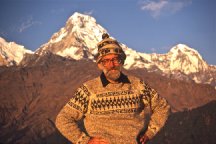
NEPAL Video Extracts Contents Part II Topic and Duration in Minutes and Seconds . |
|
John Tyman's Cultures in Context Series www.johntyman.com 
NEPAL Video Extracts Contents Part II Topic and Duration in Minutes and Seconds . |
|
16. The Environment of the Plains (217) 17. The Terai : Agricultural Background (113) 18. Rice Growing (533) 19. Village Life on the Plains (843) 20. Family Life inTown (1423) 21. Private Schools and Teacher Training (1357) 22. Housing in Town (401) 23. Retail Trading (407) 24. Road Travel (547) 25. Local Industries (832) |
|
www.johntyman.com/nepal |
VIDEO EXTRACTS PART II CONTENTS
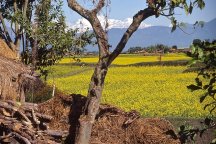 |
16. Environment of the Plains. (217) The Park of 20,00 Lakes is representative of the marshy conditions which provided ideal breeding conditions for the mosquitoes that spread the malaria which long discouraged settlement here.The monkeys that emerge from the forest cause havoc in gardens -- stripping the leaves from trees and eating any fruits in season. In Chitwan National Park elephants, which once roamed wild here, are now work animals. For many years they hauled logs from the forest: now they are harnessed to carry tourists. Local children enjoyed the river but their mother was worried about health hazards and the danger of drowning, and she called them home. |
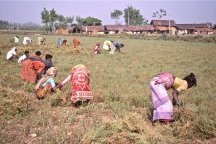 |
17. Terai : Agricultural Background. (113) With level land, an abundance of water, and -- after malaria control -- an influx of potential farm laborers displaced by loss of farm land in the hill country, wealthy land owners here are able to farm on a much larger scale than elsewhere in Nepal. These women were harvesting dhal, in the fields of a Tharo landowner. They lived in the village behind them. The Terai is also one place where farm machinery and draught animals work side by side today. |
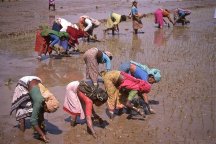 |
18. Rice Growing. (533) Conditions here (both environmental and demographic) are suited to rice production on a large scale, using both traditional and modern techniques, though the irrigation channels and the banks between the terraced fields are still maintained by hand. Traditionally the land was plowed before the field was flooded; but today, with tractors, even wet land can be worked. Harrowing is still done in the old way, smoothing the surface prior to planting. And the seedlings, raised in village nurseries, are still transplanted by hand. Later the rice will be harvested by hand also, much as it always has been. The only major differences are the scale of farming and the fact that laborers are now paid to do work that in times past would have been freely shared by family and friends. |
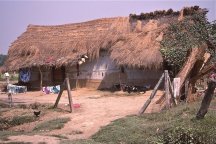 |
19. Village
Life on the Plains. (843) The introduction of machinery
has made life easier for some, but animals are still raised to serve as
beasts of burden: and life for most people here is also demanding. Transplanting
rice is still thirsty and dirty work and the women need to wash before
eating their lunch. Closer to the foothills, where carrying fodder
was more demanding, good use was made of streams. The farmer with the three
sons was spreading manure from a cart. The women weeding the corn were
working at dusk after a long days work, under the watchful eye of their
foreman. Dhal (lentils), after harvesting by hand and threshing with flails,
is winnowed with the help of the wind, as it has been for generations.
The Tharus have traditionally lived in these villages in extended family groups, in which married sons and their children live under the same roof as the grandparents. The forest that once covered the Terai was cleared long ago but enough small trees remain to provide poles for use as posts, and heavier beams are obtained from the surrounding foothills. Doors and furniture are made from planks sawn from older trees from further afield: and most roofs are thatched with straw. In the absence of building stone, the walls are made from clay mixed with chopped straw and coated with a layer of clay mixed with cow dung (to bind it together). Some of the larger landowners, though, can now afford brick walls and tiled roofs (and tradesmen to lay them). |
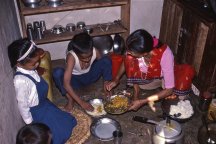 |
20. Family
Life inTown. (1423 ) Bharatpur (with a population then of about
15,000) was, like other towns on the Indian Subcontinent, crowded and noisy
-- with cars, trucks, buses, tractors, motor bikes, rickshaws, bicycles
(which could be rented cheaply), and even porters from up country, sharing
road space with sacred cows and street stalls, and salesmen hawking their
wares. A haircut and/or shave could be had beside the road: and for recreation
there were movies to watch, plus soccer, and carom (a form of billiards)
to be played in snack bars.
My fiends lived on the edge of the town beside the highway and swept and/or raked the roadside in front of our house each morning, burning the waste (to the delight of small children). To meet the needs of the many new arrivals, there were several self-help groups, including one where Bidhya learned how to sew, sponsored by an overseas development agency. Our water came from a well 20 metres deep (courtesy of a pump which failed regularly) and in varying quantities had a variety of uses -- including play. Other women collected their water from a pump near the temple. Bidhya had a small garden, which was watered by run-off from the pump and the shower. The courtyard was also a play area. Inside, Bimal and Gita memorize material in readiness for an exam the next day at their (primary) school -- in the room which serves their family as a combined bedroom and living room. All five members of the family sleep here, plus visitors. Books and papers are stored here as well as clothes. The TV was a present from a friend but it does not work. However, our home was infinitely superior to that of the squatters next door, who lived very close to the highway. |
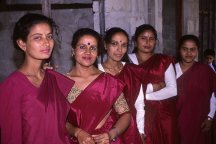 |
21. Private
Schools and Teacher Training. (1357) Nepals longstanding British
links are mirrored in its education system -- in which most of those
who can afford to do so (and many that cannot!) send their children to
private schools. At the one I visited (which then charged $20 a month,
or one quarter of Gopals salary) I was welcomed with due ceremony before
I was shown around. The language of instruction was English, but this was
sometimes heavily accented. The teachers were all college trained, and
like the students were expected to dress smartly. Recitation, reading aloud
and rote learning were standard practice, even in lower grades: and there
was a hint of military drill on the parade ground in their calisthenics.
During the lunch- break the older boys played table tennis, but the younger
pupils focussed on their lunch boxes. Saraswati is the consort of the god
Brahma and is worshipped in Nepal as the Hindu goddess of learning. After
school that day the students put on a concert for my benefit.
I also attended the opening of a four-day regional Orientation Program for a new Year 6 English syllabus. It as well attended by teachers and there was a whole panel of speakers. None of them were women, though, and the audience was dominantly male. Surprisingly, too, English was not the language of instruction -- though the teachers present were probably drawn from a variety of language backgrounds. During the break they snacked on oranges. |
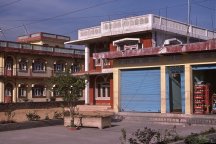 |
22. Housing in Town. (401) In designated residential sections of Bharatpur there are some expensive brick houses with satellite dishes on the roof, but many of those who live alongside the highway have squatted on land that they do not own and have built their homes from the cheapest materials. Building styles vary, but those who choose to thatch their roof must replace it when required. The waste straw will be burnt. |
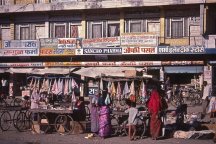 |
23. Retail Trading. (407) The centre of Bharatpur hummed with activity. There were shops, of course, but a lot of the business was transacted in a dusty street. Both shops and stalls, offered a wide range of produce -- from freshly squeezed sugar cane juice and warm snacks, fresh fish and vegetables, to bangles, books, buckets and steel reinforcing for concrete buildings. Some of the food was grown locally; some trucked in from India. |
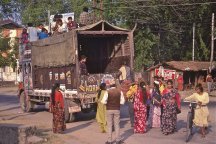 |
24. Road Travel.(547) There are lots of buses in Nepal, though many of them are veterans of service in India. Roads in mountainous areas are often in poor condition, so that travel is an adventure in itself (even on the road between Kathmandu and India). Drivers (and their passengers!) survive by sounding their horns continuously, and the wreckage of buses in the valley below can be a sobering sight! When our bus burst a tire, and we all got off, a substitute with little or no tread was fitted by the conductor while the driver smoked in the shade -- marijuana, we were told! The music, supposedly, was meant to sooth ones nerves. There were occasional police posts where drivers had to check in. The highway is divided lower down but no less dangerous. We also met with trucks crammed with passengers. |
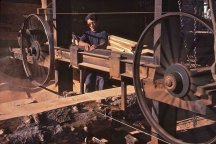 |
25. Local Industries. (832) Most of the industrial enterprises at Bharatpur were small-scale, carried out in workshops rather than factories, and sometimes involved child labour. The textile mill in Bharatpur was owned by a distant relative of Gopal, and it turned Nepalese and/or Indian cotton into face cloths and towels for export to North America. |
![]()
Text, photos, videos and recordings
by John Tyman
Intended for Educational Use
Only.
Contact Dr. John Tyman at johntyman2@gmail.com
for more information regarding
licensing.
![]()
www.hillmanweb.com
Photo processing, Web page layout,
formatting and hosting by
William
Hillman ~ Brandon, Manitoba ~ Canada